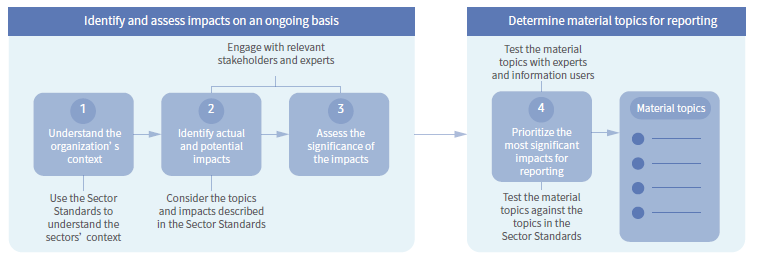Sustainable Governance
Stakeholder Communication
Stakeholder Identification
Based on the AA1000SES Stakeholder Engagement Standard's five dimensions: reliance, influence, level of concern, responsibility, and diverse perspectives, GameSparcs conducts stakeholder identification through open discussions. We then select five categories of stakeholders based on their importance: investors (shareholders), employees, partners, customers/players, and government agencies. For each stakeholder group’s areas of concern, communication is conducted through corresponding sections of the sustainability report. The company presented its stakeholder communication activities to the board on November 11, 2024.
Material Topic Analysis
When determining material topics, GameSparcs follows "GRI 1: Foundation" and engages in open discussions, surveys, or interviews with stakeholders. The company also relies on departments such as human resources, investor relations, legal and compliance, marketing and sales, procurement, and product development for communication. We refer to industry peers and domestic and international benchmark companies to understand the importance stakeholders place on different sustainability issues. Moreover, considering the industry characteristics, GameSparcs follows the Sustainability Accounting Standards Board (SASB) to identify material topics. The company regularly identifies and evaluates the impacts of these topics and works with relevant stakeholders and experts to ensure that the company proactively identifies and manages any emerging or evolving impacts.

Step 1 Understand the Organizational Context
According to the industry guidelines published by SASB in October 2018, GameSparcs belongs to the "Software & IT Services" sector. We identify all activities within the value chain and examine the relationships that occur with upstream and downstream partners. We explore the relevant issues within the sustainability context and identify key stakeholders and their areas of concern. GameSparcs' sustainability development team utilizes the AA1000 SES:2015 (Accountability 1000 Stakeholder Engagement Standard: 2015) standards for quantitative analysis. Based on the five principles (reliance, responsibility, influence, diverse perspectives, and tension), six key stakeholders are identified: investors (shareholders), employees, partners/business collaborators, customers/players, media, and local residents/society.
Step 2 Identify Actual and Potential Impacts
GameSparcs identifies the actual and potential impacts of its business activities and relationships on the economy, environment, and people (including human rights). These impacts can be positive or negative, short-term or long-term, deliberate or unintentional, reversible or irreversible. We evaluate these impacts using information from various sources, including internal data, third-party assessments, legal reviews, anti-corruption compliance management systems, financial audits, occupational safety and health inspections, and shareholder documents. A total of 16 business activities were identified, with 3 having environmental impacts, 5 with social impacts, and 8 related to corporate governance impacts.
Step 3 Assess the Significance of Impacts
Prioritizing the impacts for action is essential. The significance of the impacts is evaluated through both quantitative and qualitative analysis. The significance depends on the organization and is influenced by factors such as the industry and its business relationships. According to GRI standards, in certain cases, subjective judgment may be required. GameSparcs typically consults relevant stakeholders and considers business relationships to assess the significance of impacts, while also consulting internal or external experts when necessary. We consolidated the results of environmental, social, and governance impact assessments through 87 effective internal and external questionnaires. We also consulted key stakeholders' opinions through external partner and supplier meetings, internal board meetings, and ESG task force meetings to ensure the evaluation results are representative.
Step 4 Prioritize Reporting of Most Significant Impacts
GameSparcs' ESG task force follows the aforementioned steps and refers to GRI topic standards and industry-specific guidelines to determine the reporting order. For impacts or topics not covered by GRI standards, we refer to official documents from other intergovernmental organizations or industry guidelines. We categorize issues with an attention score of 80 or above as material topics. Additionally, we assess "financial materiality," evaluating the impact of environmental, economic, and social issues on internal financial reporting, and topics with an impact score of 55 or above are considered material. We plot a materiality matrix using environmental, economic, and social impacts as the X-axis, and stakeholder impact evaluations as the Y-axis. From this, we identify 10 major topics with high attention and impact scores, which will be disclosed as material topics in this report. Relevant GRI disclosure topics are mapped and addressed in the report.

